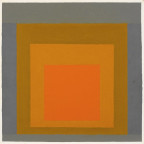Biography
Waddington Custot Galleries present 'Josef Albers: Black and White' in association with the Josef and Anni Albers Foundation. This is the first exhibition to be held in the UK which explores the importance of black and white in Josef Albers's work. Almost 50 selected works testify to Albers's versatility as an artist. Featuring paintings, works on paper, glass works, photographs and engravings on vinylite, this exhibition promises a fascinating insight into his inventive journey.
Albers explored the power of black throughout his life. His thorough use of black using multiple materials helped inform his knowledge and understanding of colour. This self-imposed restriction to monochrome allowed him to approach the full spectrum with remarkable confidence. It was a similar approach to that of other great colourists: Georges Seurat restricted his palette to monochrome for two to three years in the 1880s and Henri Matisse focused on using black around 1918.
Albers's appreciation of complex tonal contrasts as a draughtsman, printmaker and photographer would go on to influence his own pupils including Robert Rauschenberg, Cy Twombly and Kenneth Noland. It also informed his ground-breaking and influential book Interaction of Color, Yale, 1963.
Works in the exhibition include his earliest extant drawing from 1911, his Bauhaus glass constructions and photo collages. One collage of Paul Klee dates from 1929. Klee was a friend and fellow teacher at the Bauhaus, and these images were taken before both artists left Germany for the United States.
From the 1930s onwards, Albers visited Mexico on many occasions, living there for a year in 1947.
During these trips he took photographs of pre-Columbian sites. Photographs of Tenayuca and Uxmal will be on view.
An important set of six Treble Clef gouaches from the 1930s show his subtle symbioses of black, white and grey. Six Graphic Tectonic drawings from the 1940s and Structural Constellations from the 1950s show geometric precision and exemplify his wish to create 'maximum effect' from 'minimal means'. These complex linear designs offer various possible spatial interpretations and thereby create optical illusions.
Best known for his iconic series of Homage to the Square paintings, focusing on chromatic interactions, Albers created these oils, usually on masonite, for a period of over 25 years. Each consists of three or four squares of solid planes of colour. He often used strong, vibrant colours, but in this exhibition are eight examples in black and in white. Alongside these will be his Variant or Adobe paintings, their composition based on the houses in Mexico and the American southwest.
Josef Albers was a pioneering colour theorist and a historic teacher at the Bauhaus, Germany, Black Mountain College, North Carolina, and Yale University, Connecticut. His impact on contemporary art and design was and is lasting and profound.
An illustrated catalogue with essay by Nicholas Fox Weber will accompany the exhibition.
Read more








